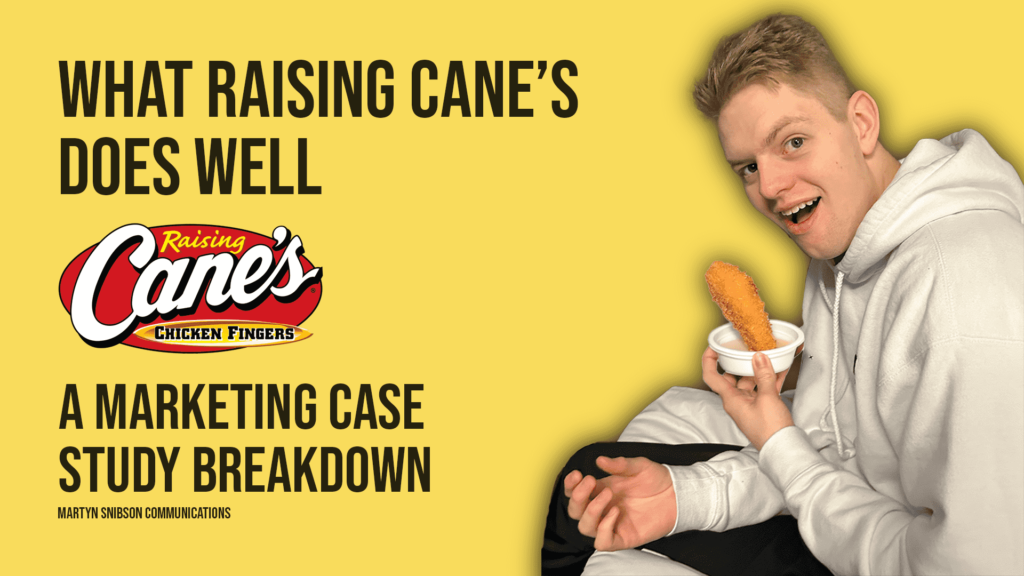
If you have been on TikTok in the last couple of months, you may have seen some Raising Cane’s chicken dipped in some oozing yet delicious Cane’s Sauce on your ‘for you’ page. What’s the fuss, you ask? Maybe Raising Cane’s marketing could have a little to do with it? So, what exactly are they doing right with their marketing you ask?
Now, I shall confess that I’m still in post-fast food worker recovery and focusing a little bit more on my health after testing and eating many amazing chicken and angus patty burgers.
The fact is that I’ll always have a deep craving for fast food.
To this day, I still subscribe to many of the ‘Fast Food Addicts’ or ‘Fast Food Updates’ Facebook pages to stay updated on any revelations in the fast food industry.
Other than the continual news that one day a Wendy’s might be coming to Australia, It was a happy surprise for many when it was announced on TikTok that “Raising Cane’s [was] coming to Australia”.
So you can imagine how I felt watching the news; it was all a hoax.
Despite this array of utter sadness, I don’t know if it has anything to do with TikTok SEO, the algorithm, or something special about Raising Cane’s marketing strategy. But I’ve continued to see Raising Cane’s videos everywhere on my feed, from Raising Cane’s Reviews to videos by fitness food gurus like Aussie Fitness creating “Low Calorie, High Protein” versions of this delicious treat.
I’ve even tried some with the cornflake batter… It was pretty damn good.
Nevertheless, back to the article, we’ll walk through what Raising Cane’s does right in their marketing (and as a brand) by outlining key takeaways and tips. Let’s get straight to the sauce… and dive in.
Table of Contents
What is Raising Cane’s?
There’s no doubt that the Americans love their chicken fingers. Just think of their competitors in the same market: Kentucky Fried Chicken (KFC) and Popeyes. As stated on Raising Cane’s website, Todd Graves, founder of Raising Cane’s, made this beautiful piece of protein his passion when he started his business venture.
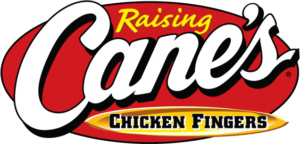
In fact, he pushed through many uphill battles to ensure that his passion would come to fruition. Despite low grades in school and rejection from banks, his commitment to quality and simplicity has become a cornerstone of Raising Cane’s marketing approach.
Raising Cane’s Marketing Strategy
Let’s break down what makes Raising Cane’s so successful and the key lessons we can draw from their marketing strategy and brand management.
1. They Nail Their Speciality
Raising Cane’s emphasises simplicity. Their small menu lets them focus on their staple product: chicken fingers. Looking at their menu, in 2024, they offer five combos, five extras, drinks and their Tailgate Chicken Finger Trays, which are primarily for multiple people, whether it’s a family gathering or a party.
Thinking of the menu size makes me often think back to the countless Gordon Ramsey Kitchen Nightmare episodes that I used to watch on repeat, where Ramsey would criticise menu sizes with remarks like “Look at the size of the F-ing menu.”
Selling a couple of key (and delicious looking) items and doing them well not only ensures Raising Canes’s product quality is top-notch but also fosters trust and loyalty amongst their customer base.
Furthermore, this allows Raising Cains to constantly refine and improve its menu offerings while prioritising its staff training and waste management. According to Jessica Elliot of ‘The Ascent’, 10% of food purchased by restaurants becomes waste lost; therefore, a smaller menu can help reduce food waste as it will help minimise the number of mistakes when preparing food items.
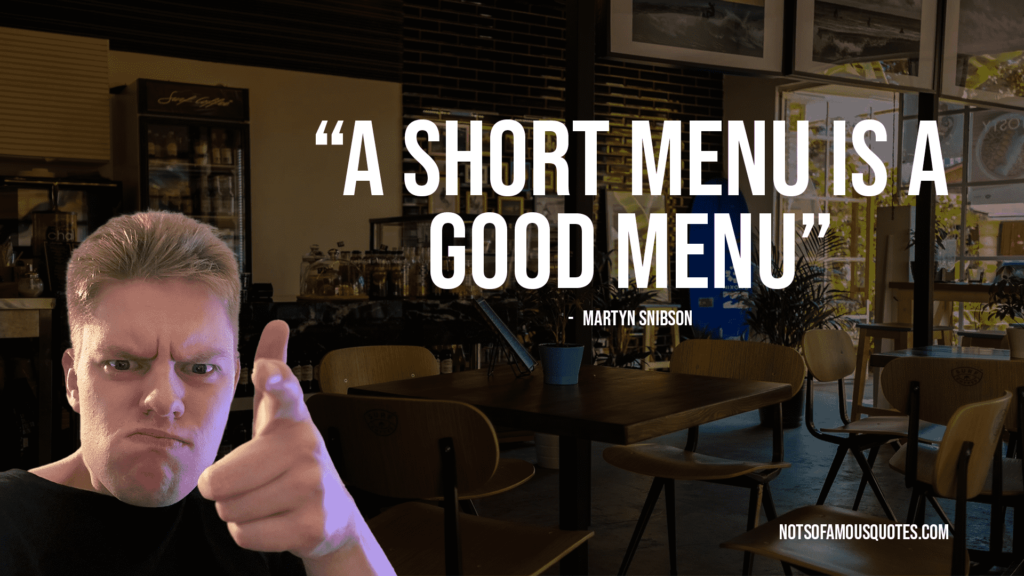
2. Consistent Branding
In addition to its focus on quality and simplicity, Raising Cane’s branding is consistent. Raising Cane’s is well-known for its simple “One Love” messaging, which relates back to its emphasis on those delicious chicken fingers.
They’ve also added a unique touch to their brand marketing through the use of their mascot, a yellow Labrador named Raising Cane, which appeals to younger audiences.
And by the way, how couldn’t you reach a younger demographic than with a Labrador that looks absolutely adorable!
3. Celebrity Partnerships and Pop Culture
There’s no doubt that Raising Cane’s has successfully leveraged collaborations with celebrities and influencers. Although many say that influencer and user-generated content is dying in 2024, in reality, it’s just changing. As said best by Alyssa Gagliardi from Later, “consumers [are] feel[ing] fatigued by an oversaturation of branded content and lack of authenticity”. By extension, consumers are tired of having products thrown at them, preferring authentic, more unbranded, Lo-Fi Content that feels simply… real.
Raising Cane’s does this well by introducing influencers that resonate well with the young adult demographic and using the lighthearted, humorous tone that Raising Cane’s uses in its communications.
A prime example of this was on Raising Cane’s Instagram, where they had creator and comedian Drew ‘Druski’ Desbodes doing some Lo-Fi Content behind the kitchen, observing and making Raising Cain’s Chicken Fingers. His young adult fanbase knows Druski well, and a majority of his fans have grown up with him since he started posting on his Instagram in 2017.
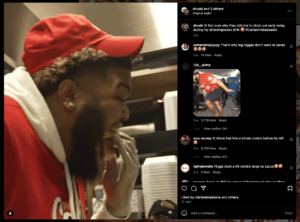
Authenticity is demonstrated by Druski being his comedic self by stealing some of the freshly prepared chicken fingers and having the employees tell him off.
4. Community Involvement
Raising Cane’s marketing strategy emphasises the brand value of “bringing people together” through their products and actions. They’re active in the communities they serve, sponsoring local events and supporting charitable causes.
It is also a great chance for the business to emphasise its corporate social responsibility (CSR) initiatives, and it also helps Raising Cane’s to become more than just another food brand selling products. This is achieved through the chain sponsoring local events and supporting charity causes, which helps build customer loyalty.
For instance, on June 6, Raising Cane’s posted a TikTok video showing their support for the Manning Passing Academy. Founder Todd Graves narrated the video, sharing an inspiring story about perseverance and passion, echoing his own journey in building the Raising Cane’s brand.
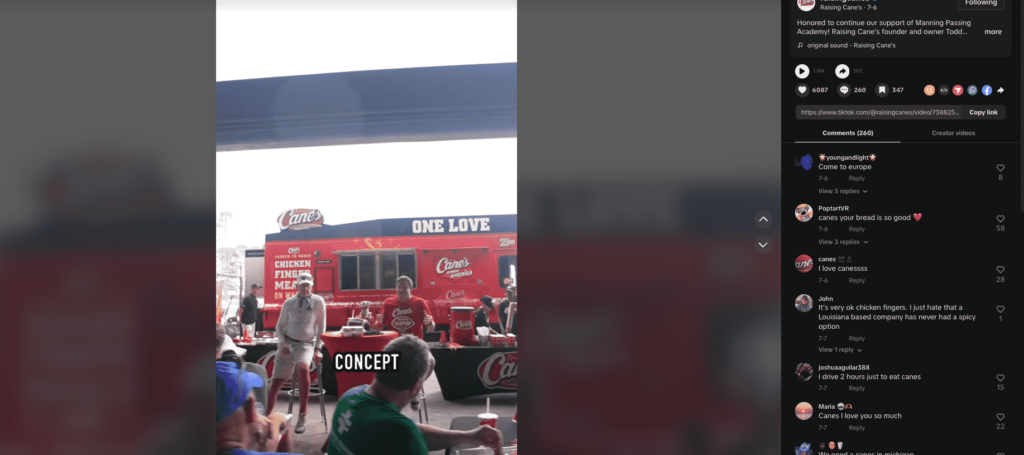
5. Raising Cane’s Merch Drops
When you think of QSR Restaurants, whether it be McDonald’s, Wendy’s, Carl’s Jr or KFC, you wouldn’t traditionally know them for being in the clothing/ accessory business.
(Mind my brother worked in fast food, and he loved it when he received a KFC Oddie as part of the KFC Youth Foundation)
Nonetheless, what Raising Cane’s does well is frequently doing brand merch giveaways, whether for social media or simply to celebrate National Chicken Finger Day (who knew that was a thing). These merch giveaways are an effective marketing strategy employed by Raising Cane’s to build a sense of community and create a sense of urgency and excitement, as these items are often ‘limited-edition’ drops.
For example, for National Chicken Finger Day, Raising Cane’s did a giveaway offering lucky fans the opportunity to win a “Chicken Finger Sleeping Bag”. Amazing right?
Furthermore, they have a dedicated website for ‘Raising Cane’s Merch’, which can be found here.
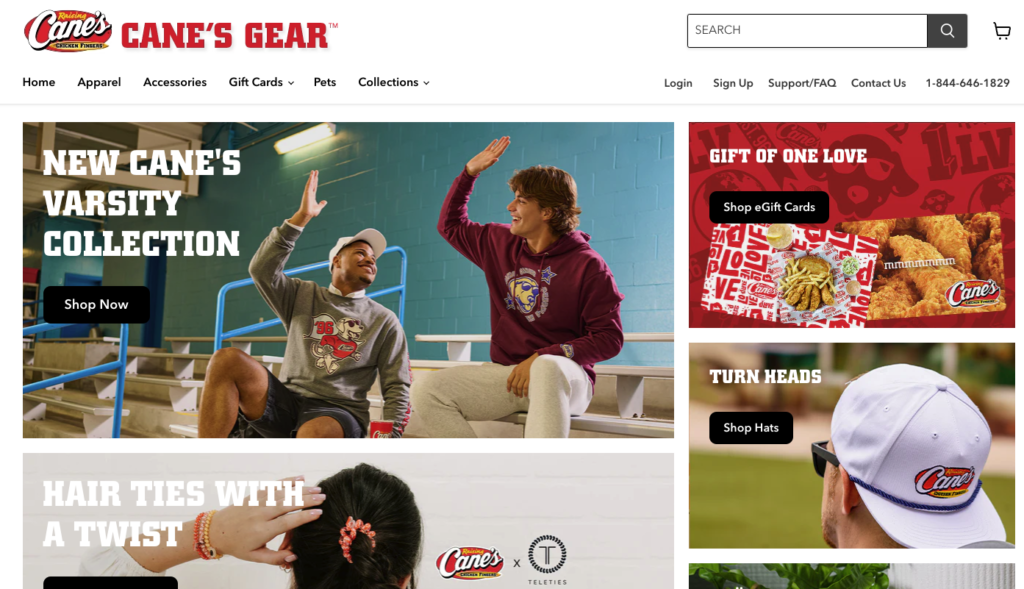
P.S. I’m not gonna lie, but I do kind of need a new bucket hat with summer in Australia coming up.
6. Social Media Savvy
Raising Cane’s has effectively used social media platforms like Instagram and TikTok to engage their younger audience. They leverage humour, memes, and user-generated content to create a strong sense of community around their brand.
Personally, I think it’s just how the algorithms have figured out my taste in video content, but I’m seeing TikToks of people testing Raising Cane’s everywhere. Despite not having a physical location in Australia, I’m also seeing a lot of content of people trying Australian Raising Cane’s equivalents.
Key Takeaways We Can Learn From Raising Cane’s Marketing Strategy
Raising Cane’s teaches us much about what to do right when developing and implementing a successful marketing strategy. Here are the key lessons to learn from Raising Cane’s marketing:
- Play to your strengths: Raising Cane’s has built its brand around a simple, focused menu that Chicken Finger die-hards can revolve around. The lesson here, therefore, is to focus your efforts on a select few products and nail them to perfection. This is better than spreading your efforts too thin.
- Leverage Pop Culture and Influencers to connect to a younger demographic: While influencer marketing has changed from the traditional shove-it-in-your-face tactics of old, Raising Cane’s chooses influencers who align with Raising Cane’s brand voice and values. They also distance themselves from being solely commercial, using authenticity and relatability through Lo-Fi Content to genuinely connect to their audience.
- Hype building: Raising Cane’s frequent and creative merchandise (merch) drops helps the company to create a sense of urgency and exclusivity, driving brand loyalty.
- Amplifying word of mouth through social media: Considering Australians don’t even have a physical Raising Cane’s location, the brand has a global presence built through social media and user-generated content to engage a wider audience.
Conclusion:
Raising Cane’s has successfully created an effective marketing strategy that matches its strengths and clearly resonates with its target audience.
They connect authentically with younger demographics by focusing on a simple, high-quality menu and leveraging pop culture and influencers.
Their strategic use of merchandise drops builds excitement and loyalty. At the same time, their social media presence amplifies word of mouth, extending their brand’s reach even in markets where they have no physical presence.
The key takeaway is clear: success in marketing lies in knowing your strengths, staying authentic, and engaging your audience in real and relevant ways. ✨
